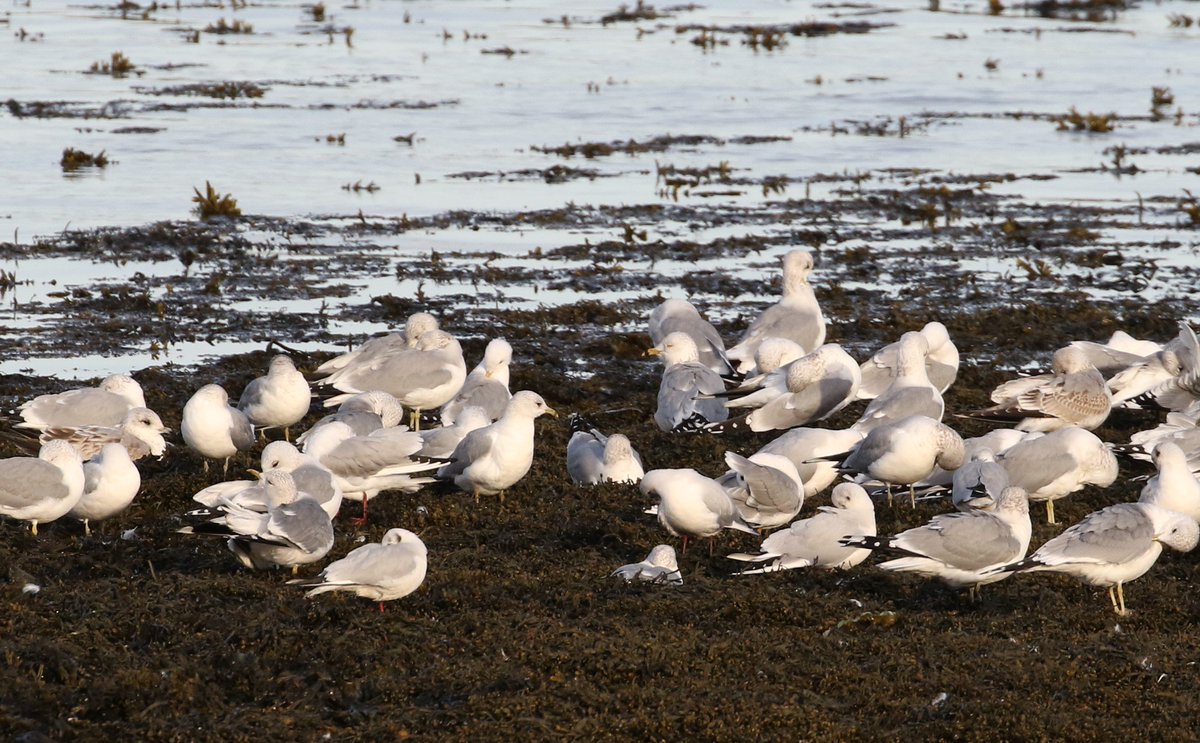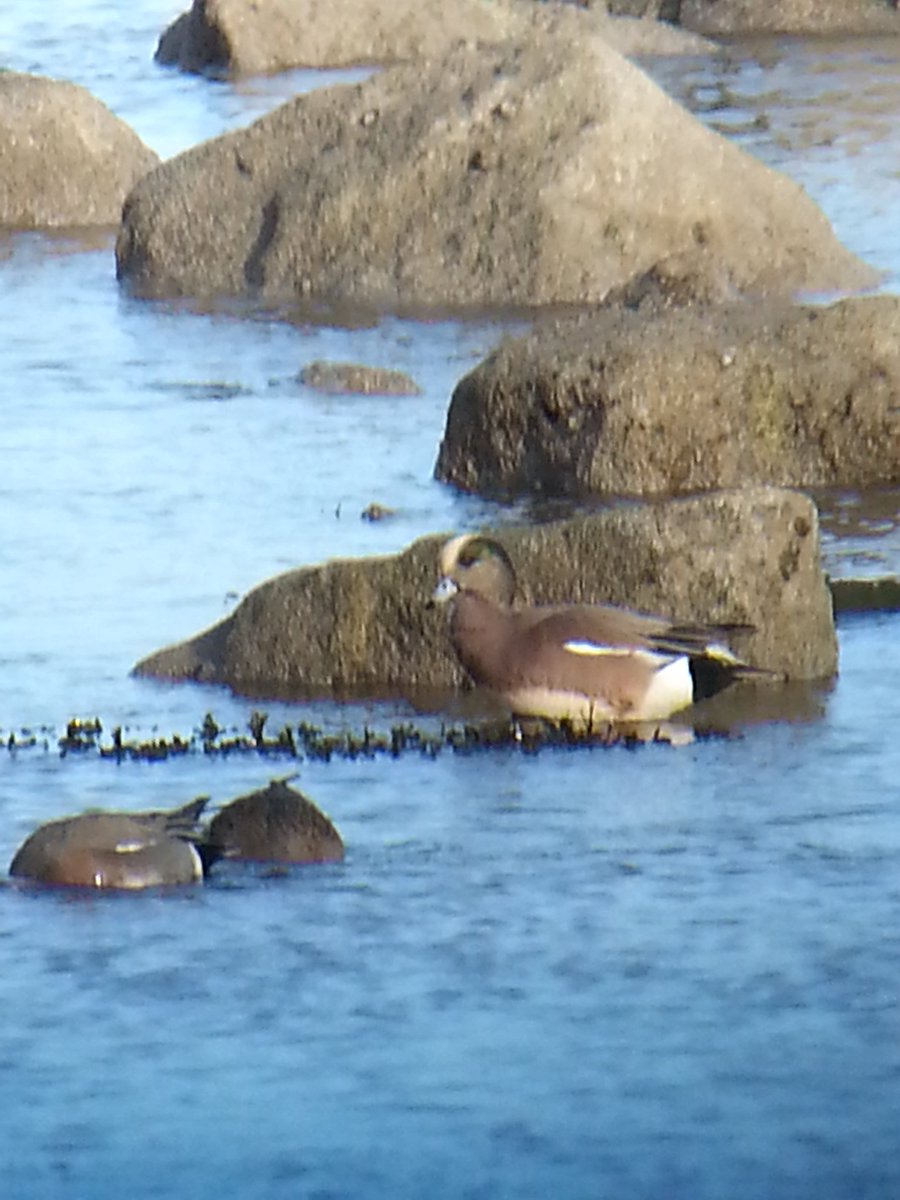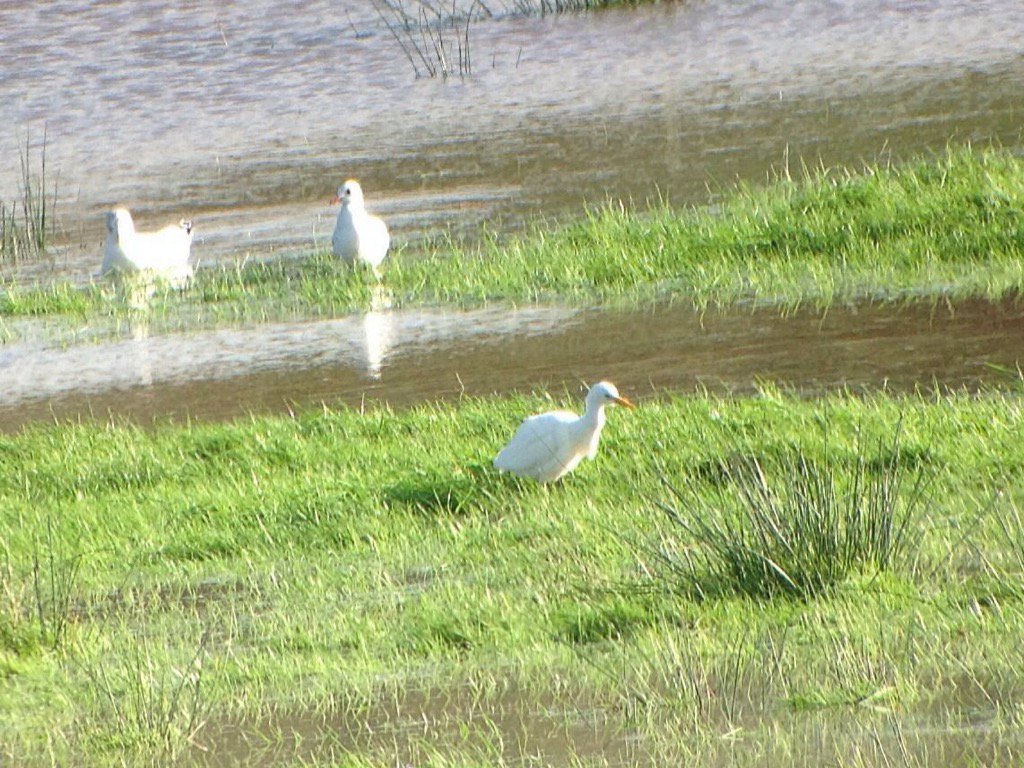January
January is normally a time to see
all the common resident birds on the patch and hope that a couple decent
seawatches can summon up a star bird such as the Red-necked Grebe and
Black-throated Diver in 2014. This January the seawatching was relatively tame,
a Shag on the 15th
probably the highlight with less than 5 records a year on average.
I didn’t have to wait long for my
first patch tick of the year as I picked out 2 tundra Bean Geese
amongst a flock of feeding Pink-footed Geese. Numbers fluctuated daily to a
maximum of 15 birds on the 16th and a couple European White-fronted Geese made an appearance on the 8th.
An added bonus to spending every morning searching through the goose flock was
another patch tick on the 7th, two Cranes flying past in the distance, a long overdue patch tick! It
didn’t end there, on the 16th a 1st winter Yellow-legged Gull was roosting next to
the flooded area of the field. Only my second ever on patch! The month ended
with a ringtail Hen Harrier hunting
over the Kings Loke area, again only my second patch record. That helped my get
to 63 species, 80 points for the
month equaling my best points tally for January.
February
February is normally a difficult
month to add many new species so adding 16 species was pleasing. Seawatching in
January may have been disappointing but in early February I added Puffin (4th patch record), Little Gull and Great Northern Diver along with a few more common seabird species I
missed in January. Highlight of the month was also my 3rd patch tick
of the year, a flock of 6 Bewick’s Swans
flying overhead. 79 species, 103 points.
Unfortunately this little cracker
was a few miles from the patch……
March
I always look forward to March as
spring migrants slowly start to drip in. The first Chiffchaff of the year on the 9th was the first spring
migrant, the first of many I was hoping but it didn’t materialise this March as
the only other migrant was a Black
Redstart on the 20th. A good passage of waders on the 21st
added Grey Plover, Knot, Ruff,
Bar-tailed Godwit, Curlew and Woodcock,
an unusual time of year for so many species to pass by. The month ended with my
earliest ever Manx Shearwater, in
fact the first one I’ve seen at Hemsby before June! 97
species, 123 points.
April
April started with a bang as a
male Serin visited my garden on the 3rd,
patch tick no.4 of the year. I only had to wait 2 more days for my next patch
tick as a Cetti’s Warbler started
singing in a garden in the village. A truly unexpected patch tick due to lack
of suitable breeding habitat. Common migrants slowly dripped through the patch
throughout the month, one of the most enjoyable months of the year as the patch
is filled with singing birds but frustratingly no other scarcities amongst
them. 121 species, 159 points.
May
May has generally disappointed me
since I’ve birded Hemsby, very few additions as all the common migrants pass
through in April and a lack of any good scarcities. Fortunately this May bucked
the trend to a certain extent. First up was another 6 pointer in the shape of a
Rough-legged Buzzard (patch tick no.6)
on the 4th, floating over my head as I tried to photograph a Garden
Warbler. A nice stroke of luck. The two Bar-headed
Geese flying in off the sea on the 8th unfortunately provided me
with zero points! Sedge Warbler on the
10th was the next good patch bird, a just about annual bird so
always good to catch up with. My 2nd ever patch Turtle Dove flew north on the 16th and my first ever
spring Hobby also flew through on the
same day. 134 species, 178 points.
June
I like June on the patch but I’m
not sure why, new species are at a premium and seawatching is incredibly dull.
My only patch Red-backed Shrike was in June 2013 and I always feel given the
right conditions that something can turn up. The 5th June was such a
day, light SE winds and sunny. As I sat in the office I felt it was a good day
for a drift migrant. After work I visited the south end of the patch where
there are paddocks and hedgerows hoping for a Hoopoe or shrike. Unfortunately
the paddocks were devoid of life and the hedgerows were similarly quiet. I
noticed a large flock of hirrundines mobbing something in the distance, soon
realised it was a falcon. The sun caught the pale head, it looked very
interesting! It landed on telegraph wires and I soon realised I was looking at
a female Red-footed Falcon! A find
tick, patch tick and beautiful bird! It was soon chased off by a Magpie, flew
over the paddocks NW never to be seen again! The rest of the month was
generally quiet, the first Crossbills
of the year on the 14th and then a Barn Owl (patch tick no.8) on a walk home from the pub on the 18th.
139 species, 188 points.

July and August
July is normally a terrible month
but August is normally a good seawatching month and migrants start returning
but this year I would see neither as work and holidays kept me away from patch
for all but four days, Black Tern
and Green Sandpiper were two good
patch birds on those days. 144 species,
194 points.
September
September is much like May at
Hemsby, I expect a lot more than I ever find. An Ortolan Bunting aside in the year
prior to PWC starting I haven’t found many good scarcities in September. Work
and holidays again limited my time on patch but a Wryneck on the 9th and my earliest Hemsby Yellow-browed Warbler (12th)
gave me some much need bonus points. Autumn was well in truly in full swing by
the end of the month when Brambling
and Great Spotted Woodpecker made it
onto my list. 151 species, 213 points.
October
The make or break month. If I was
to reach my comparative score of 251 points I needed a good October. As it
happens I had possibly the best month I will ever have patch birding! It will
take an incredible month to beat it anyway, 17 new species and a massive 61
points! It all started with a 2 pointer and my 9th patch tick of the
year. The local gulls were making an uncharacteristic amount of noise and as I
looked up I noticed them mobbing an Osprey
as it drifted south. A Rock Pipit on
the 4th was a good patch bird, only the 4th record and
all in October. Short-eared Owls
started drifting in on the 6th and by the end of the month I’d seen
15 on patch (+ 1 LEO). My 2nd ever patch Treecreeper appeared in the Kings Loke on the 9th (a
third one recorded on the 18th). A good seawatch on the 11th
saw my first patch Balearic Shearwater
pass south, tracked down the coast by several seawatchers. A Jack Snipe flew up from my feet in the Kings
Loke on the 13th, only my 2nd one on patch. All these
birds were great patch birds but they don’t make an autumn a great one. The
next five days changed that!
I left work early on the 14th
as the weather conditions were ideal for a fall of migrants. The Kings Loke was
full of thrushes and as I checked a few hedgerows a Great Grey Shrike popped up on top of the hedge. Yet another patch
tick and over the rest of October I saw 3 or 4 other GGS on patch. There had
obviously been quite a fall that evening as I walked back to my house the road
was littered with exhausted thrushes and Bramblings. A pre-work bash round the
Kings Loke on the 16th provided me with the next bonus point bird,
my third patch Pallas’s Warbler in
three years. An absolutely stunning bird, even in the rain.


The weekend of the 17th
and 18th will go down as some of the best birding I have ever done.
The 17th was actually a pretty quiet day, a Redstart the only migrant of note. While checking the Kings Loke
several times during the day I flushed a pipit several times, its call was interesting
but inconclusive and it always flew away out of view. Frustrating but just one
of those things, best let it go. At about 16:45 I was checking the dense scrub
in the Kings Loke on last time when I slight movement caught my eye at the top
of a bush at eye level. I quickly got my bins onto a greyish brown bird with
bright orange flanks and a large beady eye. I only caught a few seconds of it
before it dropped out of sight. I hadn’t seen the tail but it had to be a Red-flanked Bluetail. I managed to see
it in the middle of the bush about 10 minutes late, pumping its tail but the
light conditions were so dull that I still couldn’t pick out any blue in the
tail. The next day I was out at first light with a friend and after 1.5 hours
searching we found it again in the same bush, showed well for about 45 seconds
and we saw the blue in the tail this time, although it wasn’t obvious. A dream
find! During the 3 -4 hours after the sighting I nipped off for some food and
as I walked back I flushed the pipit from the day before. This time it perched
briefly and looked very well marked but it soon buggered off away over the
trees again. After a good 2 -3 hour search and finally getting some good photos
we were happy we had stumbled across an Olive-backed
Pipit, less than 50m from the Red-flanked Bluetail!!! What a day! What a
month! My comparative score well and truly smashed thanks to two birds! 168 species, 274 points.


November
Despite having a great autumn so
far the seawatching had been pretty terrible all autumn so I was hoping for a
few good seawatches in November. The first three weeks didn’t produce good
seawatching conditions and additions were few and far between, a Merlin on the 7th and a
small group of Whooper Swans on the
8th, both less than annual on patch. The Humpback Whale reappeared
in front of my house for the 3rd year running on the 9th
and was seen throughout most of the month thereafter.

Many people think of great
seawatches containing thousands of shearwaters or hundreds of skuas and petrels
but for my patch they can be as simple as a good passage of waders or wildfowl.
The 21st and 22nd provided just that, northerly gales
produced unprecedented numbers of wildfowl and to a lesser extent waders along
with a few good scarcities. I seawatched for 9 hours straight on the 21st,
5 year ticks and record counts galore later I was a very cold but happy
patcher. All the year ticks were patch gold, 2nd patch records of Pochard, Goosander, Leach’s Petrel and
a 3rd patch Avocet on the
21st and on the 22nd an Iceland Gull was a patch tick (14th of the year!), 3rd
patch record of Purple Sandpiper and
a record count of 14 Little Auk. On
top of this there were patch record counts of Wigeon (1025), Teal (728), Pintail (162), Goldeneye (105), Shelduck (179),
Red-breasted Merganser (26), Shoveler (38), Eider (113) and Dunlin (378). Epic patch birding! 176 species, 292 points.
December
Prior to PWC 2015 I had only ever
added one species in December, a waxwing in 2014 so I wasn’t holding out for
much and so it proved with only one addition but again another bit of patch
gold, my 2nd Red-necked Grebe
for Hemsby on the 11th.
This finished off a quite amazing
year on patch, 2016 has a lot to do to keep up……
177 species
294 points
14 patch ticks - Bean Goose,
Crane, Bewick’s Swan, Serin, Rough-legged Buzzard, Cetti’s Warbler, Red-footed
Falcon, Barn Owl, Osprey, Balearic Shearwater, Great Grey Shrike Red-flanked
Bluetail, Olive-backed Pipit, Iceland Gull
1 x 15 pointer – Red-flanked Bluetail
1 x 12 pointer – Olive-backed Pipit
9 x 6 pointers – Crane, Serin, Rough-legged Buzzard, Red-footed Falcon,
Wryneck, Yellow-browed Warbler, Great Grey Shrike, Pallas’s Warbler, Leach’s
Petrel
0 Twitches
Patch Gold – Whooper Swan (4th & 5th patch
records), White-fronted Goose (3rd & 4th), Pochard & Goosander (2nd & 3rd), Red-necked Grebe (2nd),
Hen Harrier (2nd, 3rd & 4th), Avocet (3rd),
Purple Sandpiper (3rd), Common Sandpiper (5th), Green
Sandpiper (4th), Jack Snipe (2nd), Puffin (4th
& 5th), Yellow-legged Gull (2nd & 3rd),
Turtle Dove (2nd), Long-eared Owl (4th & 5th),
Merlin (3rd), Sedge Warbler (4th & 5th),
Treecreeper (3rd &a 4th) and Rock Pipit (3rd
& 4th).
Birdtrack records – 7508
Birdtrack complete lists – 237

















































